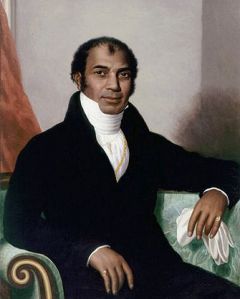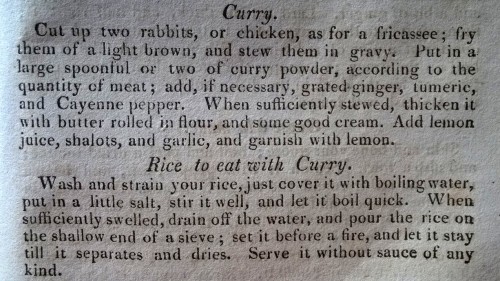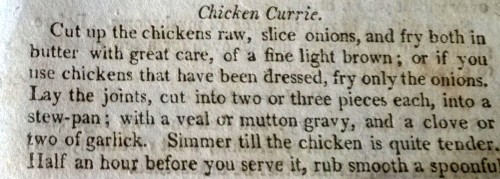Some time ago I bought a battered little book from an on-line auction site for a few pounds. It measures approximately 8 x 6.5 inches (10 x 6 cm), the cover was battered and the thin spine had given way completely. The pages inside were loose and covered in handwriting in ink that, in places, had faded badly.

Many pages were difficult to read but I saw at a glance that it was what I had hoped – a book of household recipes and hints that some careful 19th century housewife had collected. But who was she and when did she keep her notebook?
Inside one cover was “9, High Row 60£” and “G.G.Mills Esq, North End Terrace, Fulham”. Somehow I didn’t think that Mr Mills himself was carefully collecting recipes for raspberry vinegar or fish sauce. The other cover, amidst various scribbled notes, had, “Mrs Bernard Ryan”, the date 31st August 1812 and “Kensington Wilds Library Hornton St.” There was also a strip that had been torn from a letter and stuck in with instructions for restoring the lustre to silverware written on it. The letter had been addressed to Mrs Mills. The glue obscures the notes in the top left hand corner of the inside cover but it is possible to read “1819 Sept 21st”, “G.G.M 10th Dec 1819” and very faintly below that “To make good curry.”

So, I had a Regency housewife’s notebook – but if this belonged to Mrs Mills, who was Mrs Bernard Ryan? And why had someone apparently tried to copy Mrs Bernard Ryan’s name in wobbly handwriting above it as “Mrs Renard Ry”? A child, perhaps?
I began with the library by digging in on-line newspaper indexes and soon found that F. P. Wild’s Library at 8, Hornton Street, Kensington appears in newspaper advertisements for newly-published books between 1816 and 1825. It seemed I was definitely dealing with someone living in London
Then I turned to genealogy websites and discovered that a George Gillam Mills was resident at North End Terrace, Fulham when he died in May 1844 aged 74. He was buried in the District Chapel of the Parish of St Mary’s, North End, Fulham on 17th May. I tried to find North End Terrace on maps but could not pin-point it but but North End Road joins Hammersmith Road just where St Mary’s Chapel, now a church, stands. It seems likely that it was at the northern end of the road that Jean and George lived. Until the late 19th century North End was a scattered hamlet of houses along North End Road surrounded by fields and market gardens and included many substantial properties and villas owned by prosperous middle class and aristocratic families.
Now I knew Mr Mills’ first names I could chase him further and found that on the 15th May 1815 he had married Jean Ryan, a widow, at St Luke’s, Chelsea. They had married by licence and on the bond which he signed to obtain the licence George stated that he was over twenty one years of age, unmarried and living in the parish. It seemed highly likely that Jean Ryan was the Mrs Bernard Ryan named on the inside cover of the book.
I was able to find George’s christening record at St Alfege’s church in Greenwich on 24th November 1771 with the note that he had been born that month. His parents were Samuel Gillam Mills, a surgeon, and Catherine. So George was from a middle class home and was forty four when he married Jean Ryan.
Could I find ‘Jean’ marrying a Barnard Ryan? To my delight I found that on 26 August 1805 Lieutenant Bernard Ryan married Miss Jean Forbes in Secunderabad in British controlled India. But sadly the marriage lasted only six years. He died, a Captain in the 12th Regiment of Native Infantry of the Honourable East India Company, aged twenty eight and was buried 17th October 1811 at Fort William in Calcutta (now Kolkata). His will leaves everything to his wife Jean.
This image of the fort is from 1754, but it must have looked very much like this when the Ryans knew it, and having seen it when in Kolkata myself, it is still recognisable today.

In September 1812 the records of the Lord Clive Military Fund Pensions Committee in the Madras (now Chennai) Presidency show that a pension of two shillings and four pence a day was granted to Mrs Jean Ryan, widow. Soon after this she must have set sail for England, a voyage of perhaps a year unless she was very lucky with the weather.
How did the widowed Mrs Ryan meet Mr Mills? How old was she? That at least I could answer because her burial record for 19th March 1825 gives her age as only forty. She had been twenty when she married Bernard and thirty when she married George. But her second marriage to a man fourteen years her senior seems to have been a happy one because below a recipe for stewing flounders she wrote: “13th April 1820 – recd. a New Crown Piece from Darling Husband. Keep Sake.”
What happened to George? He was a prosperous businessman and civil servant, it seems. In 1815 he was Cashier of Half-Pay at the Army Pay Office in Whitehall and in 1819 had been promoted two steps up to Ledger Keeper. The Royal Kalendar and Court and City Register for 1817 and 1819 lists him as one of the directors and an auditor of the British Fire Office, “for assuring Houses, Goods and Ships” located at Cornhill in the City. How did he pass the nineteen years of widowerhood? I hope he had a good housekeeper who cooked him some of the familiar recipes from Jean’s notebook.
The notebook itself has a wide selection of recipes with notes on who gave them to her, a good selection of curries – not surprisingly perhaps – and notes on everything from making mistletoe grow to polishing a mahogany table. I transcribed the whole book and Mock Oyster Sauce and a Cure For Corns: A Regency Lady’s Receipt Book is out in April but available to pre-order now.






 For a fascinating history of Europe’s love affair with curry, try Lizzie Collingham’s Curry; a biography (2005).
For a fascinating history of Europe’s love affair with curry, try Lizzie Collingham’s Curry; a biography (2005).